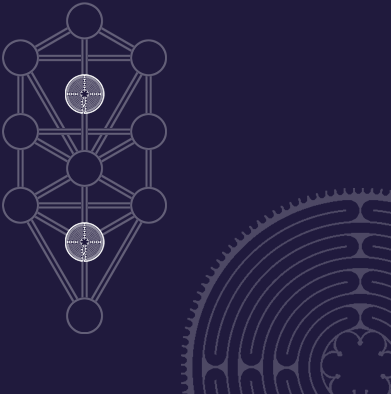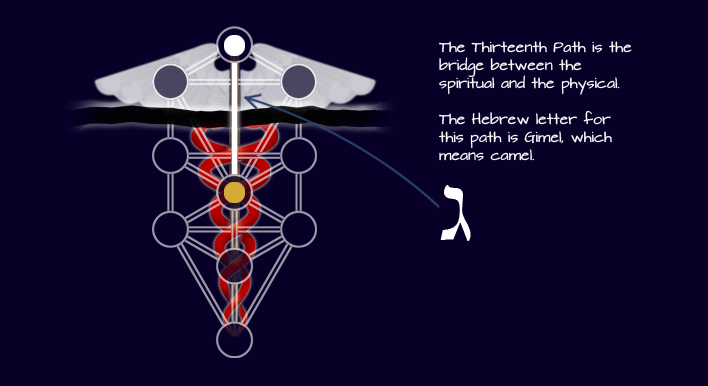(ii) The Vision Across The Abyss
Following the girls, I set off to find a route through the labyrinth. In my minds eye I see an Abyss stretching across the labyrinth, which must be crossed to reach the far side.

Having finally found a path through the labyrinth we arrive at the second monolith, different from the first in that there’s a hole running through this one. Invited to peer through the hole, the viewer gets a clear line of sight over the top of the labyrinth to the first stone. In other words, a vision across the Abyss.
(SYMBOLISM OF THE LABYRINTH)
Winding our way though the Labyrinth of life, our attention is at first focussed on the layout – the twists and turns, the dead-ends, the convoluted paths that mark the Material World. Navigating successfully, we come to the stone that marks our destination, where our perspective alters – instead of focussing on the structure of the maze we are presented with a clear line of sight, over this thing we call life. The twists and turns are merely Maya, illusion. The walls of the maze fall away and we see Life as it truly is, boundless. We have experienced the Vision Across the Abyss.

In Qabalistic literature, the Labyrinth is more commonly associated with the Underworld and placed upon Yesod, the ninth sphere of the Tree.
However, Daath and Yesod create a magical circuit of polarity, which makes the symbolism of the Labyrinth entirely suited to this sphere.
Inscribed around the hole is the phrase
On the Tree of Life, the ‘straight and narrow way’ corresponds to the Thirteenth Path.

Like the Twenty-fifth Path before it, the Thirteenth Path is commonly seen as a journey into the desert, making the camel an apt symbol.
Such is the extent of my appreciation of the symbolism, until Paul makes another innocent yet highly appropriate remark. We are walking along the lip of the moor, chatting about the second monolith – the stone with the hole running through – when Paul says, “For me, that stone has always been the eye of the needle.”
The camel connection flares in my mind, along with a flash of insight into the nature of the Thirteenth Path.
(ENTERING LIGHT : THE WAY OF THE THIRTEENTH PATH)
The ‘eye of the needle’ phrase comes from the Bible:
It is easier for a camel to pass through the eye of a needle than it is for a rich man to enter the Kingdom of God.
Matthew 19:24
The “Kingdom of God” is another term for the World of Spirit. In order to enter, we have to let go of whatever is tethering us to the World of Manifestation. A rich man – someone burdened with material-world attachments – faces a greater challenge than someone free from all the ‘trappings’ of wealth.
The word “rich” refers not only to an accumulation of material possessions. In the section of The Shining Paths devoted to the Thirteenth Path, Dolores Aschroft-Nowicki also writes of an unburdening.
The only thing that can help you is what you have learned on these paths. Yet that knowledge will be stripped from you. So you must fall back on the only thing you have left, your need to go forward and experience Kether.
Dolores Ashcroft Nowicki, The Shining Paths
Daath means Knowledge. Yet there is something about crossing the Abyss, travelling through Daath, which requires the relinquishing of knowledge. To make the leap across the Abyss we have to put everything aside, surrendering preconceptions. We have to let go of what has been learnt in order to enter pure experience.
These two quotations tie in with a third, a line from a letter penned by TH Huxley, one of the greatest advocates of biological evolution. It is the sentence from which the words on the entrance stone of the Ilkley Labyrinth were taken.
Sit down before a fact as a little child, be prepared to give up every preconceived notion, follow humbly to wherever or whatever abyss nature leads you, or you shall learn nothing.
TH Huxley
All three excepts are concerned with puting aside knowledge and stepping into the unknown.
What I don’t yet know is that I will soon be taking my very own journey onto the Thirteenth Path.

 TOP
TOP NEXT
NEXT